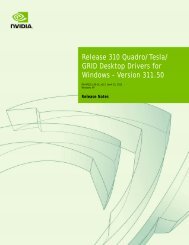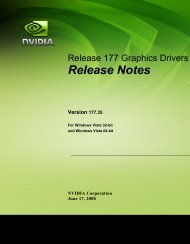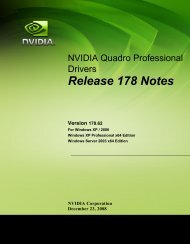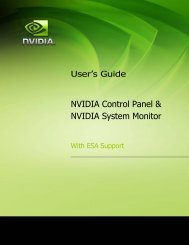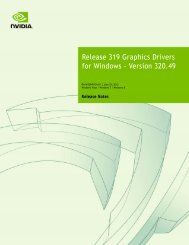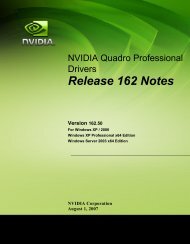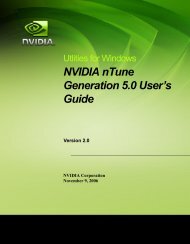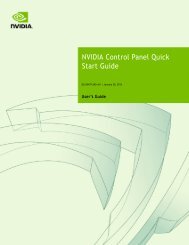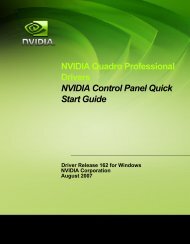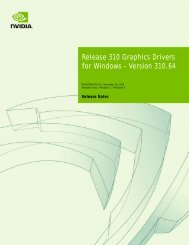Release 295 Quadro & NVS Notebook Drivers for Windows ... - Nvidia
Release 295 Quadro & NVS Notebook Drivers for Windows ... - Nvidia
Release 295 Quadro & NVS Notebook Drivers for Windows ... - Nvidia
Create successful ePaper yourself
Turn your PDF publications into a flip-book with our unique Google optimized e-Paper software.
of available memory and potentially undesirable behavior of applications that rely on<br />
these APIs to report available memory.<br />
The reported memory can be severely reduced. For example, 6 GB might be reported as<br />
454 MB, and 8 GB might be reported as 1259 MB.<br />
NVIDIA Action <strong>for</strong> non-<strong>Quadro</strong> based Systems<br />
Recent NVIDIA display drivers constrain TAG memory to just below 4 GB 1 . In these<br />
scenarios, the Shared System Memory component of TAG is limited first, be<strong>for</strong>e limiting<br />
Dedicated Video Memory. This is a policy decision within the driver.<br />
This results in reliable reporting of sub‐4 GB TAG memory.<br />
NVIDIA Action <strong>for</strong> <strong>Quadro</strong>-based Systems<br />
The un<strong>for</strong>tunate side effect of constraining TAG on systems with larger amounts of video<br />
and system memory is that memory which otherwise would be available <strong>for</strong> graphics use<br />
is no longer available. Since shared system memory is limited first, driver components<br />
and algorithms utilizing shared system memory may suffer per<strong>for</strong>mance degradation<br />
when TAG is constrained.<br />
Since this and similar scenarios are prevalent in many Workstation applications, but less<br />
so in more mainstream Consumer applications, the NVIDIA driver now avoids<br />
constraining TAG on <strong>Quadro</strong>‐based systems (which are used primarily in the<br />
Workstation applications).<br />
This has been a conscious decision by NVIDIA to trade off better Workstation application<br />
per<strong>for</strong>mance <strong>for</strong> potentially less desirable per<strong>for</strong>mance on applications which rely on the<br />
suspect memory reporting APIs.<br />
Using HDMI/DisplayPort Audio with Displays that have a<br />
High Native Resolution<br />
To use HDMI/DisplayPort audio with some displays that have a native resolution higher than<br />
1920x1080, you must set the display to a lower HD resolution.<br />
Some HDMI TVʹs have a native resolution that exceeds the maximum supported HD<br />
mode. For example, TVs with a native resolution of 1920x1200 exceed the maximum<br />
supported HD mode of 1920x1080.<br />
Applying this native mode results in display overscan which cannot be resized using the<br />
NVIDIA Control Panel since the mode is not an HD mode.<br />
1. The WDDM guidelines dictate minimum and maximum values <strong>for</strong> the components, but the dis‐<br />
play driver may further constrain the values that are reported (within the allowed minimum and<br />
maximum).<br />
<strong>Release</strong> <strong>295</strong> <strong>Quadro</strong> & <strong>NVS</strong> <strong>Notebook</strong> <strong>Drivers</strong> <strong>for</strong> <strong>Windows</strong> - Version 296.88 RN-WQ29688-01n_v02 | 10



